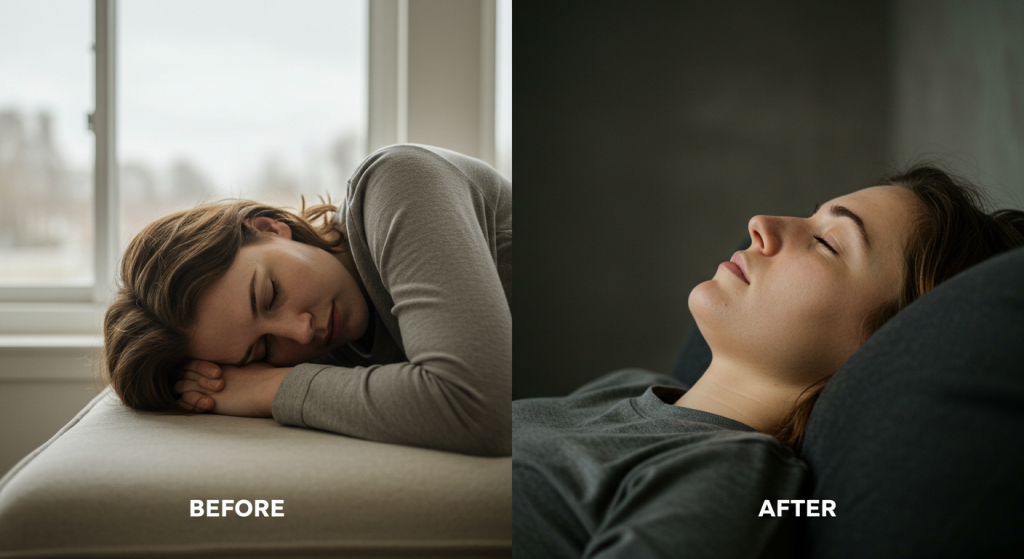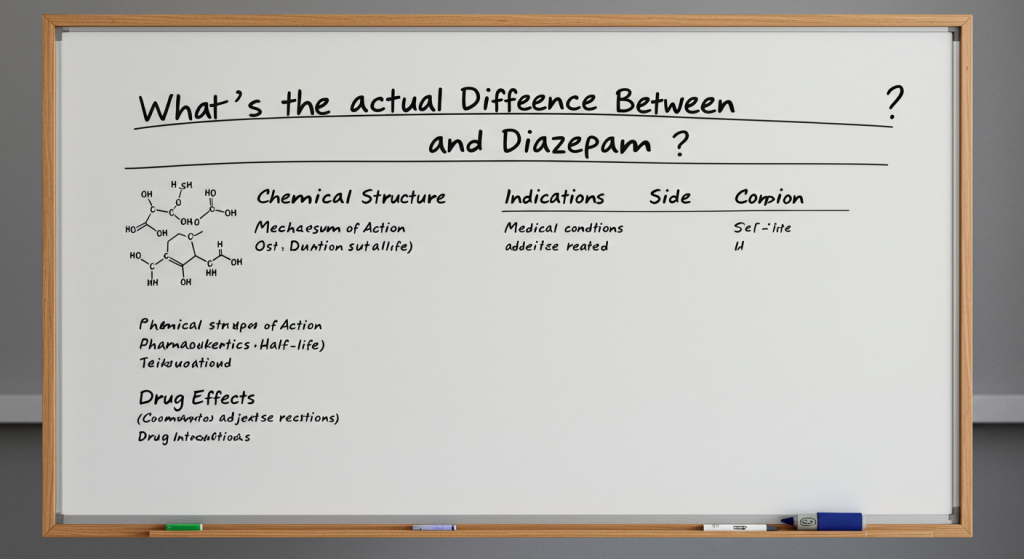When it comes to managing anxiety, stress, and certain medical conditions, benzodiazepines are often prescribed as a solution. Among the most commonly used benzodiazepines are lorazepam and diazepam. Both medications are effective at calming the brain and nerves, but they have distinct differences in their uses, effects, and duration of action. Before you buy lorazepam online or diazepam, make sure to understand your individual needs.

Lorazepam vs Diazepam
| Characteristics | Lorazepam | Diazepam |
| Onset | 30-60 minutes | 15 – 60 minutes |
| Duration | 8 -12 hours | 10 -12 hours |
| Half life | 10 – 20 hours | 20 plus hours |
| Uses | Anxiety, panic attacks & insomnia | anxiety, muscle spasms, seizures, and alcohol withdrawal symptoms |
Lorazepam and Diazepam both belong to the Benzodiazepine group of drugs and do have a similar set of functions. However, we can see a slight difference in their onset, duration of action and half-life. Based on the patient’s health condition these are prescribed for specific conditions.
Lorazepam is Good For!
Overall, upon research, it’s evident that Lorazepam does have a lot of benefits along with risks and shortcomings. It comes with a short half-life that may require frequent doses. But provide an ideal short-term management of anxiety. Coming with a relatively quick onset of action, the drug is effective for immediate relief of symptoms.
Like other Benzodiazepines, this one does have side effects but comes with a lower risk of accumulation in the body. It automatically reduces the likelihood of prolonged side effects. However, upon using the drug, you may feel sedation, and drowsiness which can impact daily functioning.
Does Diazepam Stands Out?
Diazepam as compared to Lorazepam comes with a better half-life and onset that offers a good relief and reduces the need for multiple doses. It’s commonly used to treat anxiety, muscle spasms, alcohol withdrawal, and seizure disorders. Which are definitely more than the limited uses of Lorazepam. Along with the anxiety troubles, it helps to cover other symptoms as well.
A long duration of action makes it a better choice for managing chronic anxiety or conditions. Patients requiring continuous relief can depend on this drug in routine.
However, the long half-life can lead to a risk of drug accumulation. It’s specifically critical for the patients with liver problems, resulting in prolonged sedation or overdose. It does have a sedation effect on patients causing them to face drowsiness and other reactions. At the same time the medicine is not as efficient as Lorazepam for the patients requiring quick relief.
Which One Should You Choose?
The choice between lorazepam and diazepam depends largely on the specific medical conditions and the individual’s needs. Both the drugs cannot work for everyone in the same manner. If you are looking for a quick, short-term relief from anxiety or stress, lorazepam may be the better option. It offers you rapid onset and short duration. However, in the cases of chronic anxiety, muscle spasms, or seizure, diazepam provides more consistent relief.
For those with impaired liver function, lorazepam might be preferred due to its quicker elimination from the body. As Diazepam can stay longer in the system and worsen the liver condition if taken regularly even for a short term.
Ultimately, the decision between lorazepam and diazepam should be made in consultation with a healthcare provider. A professional will consider your specific medical needs and offer assistance accordingly. Moreover, buy these drugs from a safe source like Direct Online Pills. Here you will get the best and safe medicines with lasting effect.
Explore: https://megapersonals.co.com/blog/what-is-erome/
Why Benzodiazepines Matter in Everyday Life

If you’ve ever experienced intense anxiety, had trouble sleeping for nights on end, or dealt with persistent muscle spasms, you know how exhausting it can be. That’s where medications like lorazepam and diazepam have helped people feel more like themselves again.
They’re part of a group of drugs called benzodiazepines, which work by enhancing the effect of a neurotransmitter in the brain called GABA (gamma-aminobutyric acid). This calming chemical naturally reduces nerve activity and helps bring a sense of relaxation and stillness.
Benefits of Benzodiazepines in Practical Life
- Rapid symptom relief: Often effective within minutes to an hour
- Short-term anxiety control: Helpful during high-stress events or panic attacks
- Muscle relaxant properties: Especially useful for tension and spasms
- Seizure prevention: Widely used in emergency medical settings
- Support in alcohol withdrawal: Helps reduce agitation and risk of seizures
Many people benefit from short-term use of these medications during particularly stressful periods in life. But since no two medications are exactly the same, understanding their differences matters a lot.
What’s the Actual Difference Between Lorazepam and Diazepam?

While both drugs come from the same class, their individual profiles vary in key ways: how long they stay in your system, how quickly they work, and what symptoms they target best. That makes one better suited for certain situations over the other.
Here’s a practical breakdown:
| Feature | Lorazepam | Diazepam |
|---|---|---|
| Onset of Action | 30–60 minutes | 15–60 minutes |
| Duration | 8–12 hours | 10–12 hours |
| Half-Life | 10–20 hours | 20–70 hours |
| Metabolism | Liver (minimal active metabolites) | Liver (active metabolites) |
| Common Uses | Anxiety, panic attacks, insomnia | Anxiety, muscle spasms, seizures, alcohol withdrawal |
| Formulations | Oral, injectable, sublingual | Oral, rectal, injectable |
So what does this all mean in plain terms?
- If you need quick relief and have short-term anxiety, lorazepam might work better.
- If your condition needs ongoing control (like seizures or alcohol withdrawal), diazepam’s long action time can be more helpful.
When Would a Doctor Choose One Over the Other?

This usually depends on the clinical scenario, your age, existing health conditions, and even liver function. Here’s how medical providers typically make that decision:
Situations Where Lorazepam Is Commonly Prescribed
- Sudden panic attacks or intense anxiety episodes
- Insomnia that needs short-term treatment
- Situations needing reduced sedation duration
- Liver impairment or elderly patients (due to fewer active metabolites)
When Diazepam Makes More Sense
- Long-term management of seizure disorders
- Alcohol detoxification under medical supervision
- Muscle spasm treatment after injury
- Patients needing fewer daily doses
How Do They Feel in Real Life?
Here’s where personal experience matters. I’ve talked to people who felt calm within half an hour of taking lorazepam, able to face stressful situations that otherwise left them frozen. On the other hand, someone taking diazepam after back surgery appreciated the way one dose kept muscle spasms in check all day.
But side effects are something no one should ignore.
What Side Effects Should You Know About?
Like all medications, both come with possible downsides. The intensity can vary based on dosage, frequency, and your unique biology.
Common Side Effects (For Both Medications)
- Drowsiness
- Dizziness
- Confusion (especially in older adults)
- Muscle weakness
- Memory problems
- Dry mouth
Specific Concerns
- Lorazepam: Short half-life, may require multiple doses a day
- Diazepam: Longer half-life, greater risk of drug accumulation
In people with liver disease, diazepam can build up, leading to prolonged sedation. Lorazepam is often preferred in such cases due to cleaner metabolism.
How Addictive Are These Medications?
Dependency is a serious risk with benzodiazepines if they’re used daily over weeks or months. Tolerance can develop, meaning higher doses are needed for the same effect, and withdrawal symptoms can appear when stopping.
Real-life example: A friend of mine used diazepam daily for muscle spasms and found herself needing higher doses just to maintain the same relief. Tapering off required strict medical supervision and a lot of patience.
Can You Combine Them With Other Medications?
This is one of the most important questions to ask your healthcare provider. Benzodiazepines interact with many drugs, especially:
- Opioids (increased risk of respiratory depression)
- Antidepressants
- Antihistamines
- Alcohol (can dangerously amplify sedation)
Always disclose all medications you’re taking before starting either of these.
Are There Safer Alternatives?
For some people, non-drug treatments or alternative prescriptions may work just as well:
- Cognitive Behavioral Therapy (CBT) for anxiety
- SSRIs or SNRIs for long-term mood disorders
- Muscle relaxants like cyclobenzaprine for spasms
- Melatonin or zolpidem for insomnia
These don’t offer the same rapid relief but can help manage symptoms long-term without the risks associated with benzodiazepines.
Legal and Safety Aspects: Can You Buy Them Online?
Technically, you can buy medications like lorazepam or diazepam from online pharmacies—but that doesn’t mean you should. Many online platforms operate illegally or sell counterfeit drugs that look legitimate but aren’t.
Red Flags When Shopping Online
- No prescription required
- Unrealistically low prices
- No pharmacist consultation
- Poor customer service or missing contact info
Only buy from licensed online pharmacies that verify prescriptions and offer real pharmacist support. Safety first—always.
How Much Do They Cost?
Pricing can vary depending on your region, brand vs. generic options, and insurance coverage. Here’s an estimate (in USD):
| Medication | Average Retail Price (per 30 tablets) |
|---|---|
| Lorazepam 1mg | $10–$30 (generic) |
| Diazepam 5mg | $8–$25 (generic) |
Keep in mind: prices fluctuate. Always check with a trusted pharmacy.
Are These Drugs Approved Worldwide?
Yes. Both medications are listed on the World Health Organization’s List of Essential Medicines, and approved by regulatory agencies like the FDA, EMA, and TGA. They’re widely used in emergency rooms, psychiatric hospitals, and outpatient clinics globally.
Final Thoughts: Which One Is the Best Buy for You?
Choosing between lorazepam and diazepam isn’t about which one is “better” overall—it’s about which one is better for your specific need. Think of them as tools: one may be perfect for a quick fix, the other better for a longer job.
If you:
- Need rapid anxiety relief with fewer lingering effects → lorazepam may be ideal
- Are managing ongoing conditions like seizures or alcohol withdrawal → diazepam may be a better fit
But always talk with a licensed medical provider. They’ll assess your medical history, your lifestyle, and your goals before suggesting anything.
Conclusion
There’s no one-size-fits-all answer when it comes to medications that affect the brain and nervous system. Lorazepam and diazepam each have their strengths and limitations, and the best choice depends on your unique situation. Use them responsibly, understand the potential risks, and never hesitate to ask your doctor the hard questions.
Feeling overwhelmed? That’s normal. But with the right guidance, clarity is just a conversation away.






